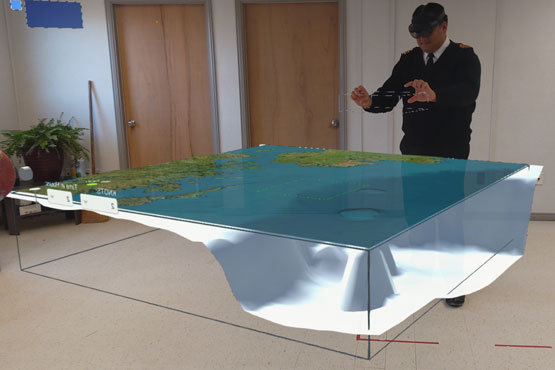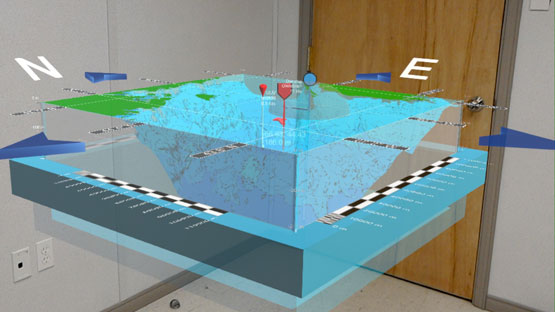February 8, 2024
Augmented reality offers potential advantages for the Royal Canadian Navy (RCN) to be able to visualize in three dimensions the battlespace both above and below the surface of the water.
“A two-dimensional map doesn’t give a full appreciation of the physical features, or topography, of the ocean floor,” explains Dr. Aren Hunter, group leader of the maritime command team support group at DRDC Atlantic Research Centre. “This is really important for the Navy because submarines can hide in these natural features making them difficult to find.”

LCdr George Chu uses an augmented reality headset to manipulate a three-dimensional model of a battlespace.
Dr. Hunter leads a team of three women defence scientists at DRDC’s Atlantic Research Centre in experimenting and validating prototypes to improve Command team decision making.
“Augmented reality offers advantages over virtual reality because it overlays information, while maintaining awareness of the physical world in the ship, which is important for ensuring safety and awareness in an operational setting,” says Tania Randall, the defence scientist leading the augmented reality project in Dr. Hunter’s group.
Dr. Hunter applies her background in experimental psychology and human factors research to study how people use technology and how that impacts decision making.

Augmented reality could help the Royal Canadian Navy visualize in three dimensions the battlespace both above and below the surface of the water.
For example, the augmented reality interface can also make it easier to see where there are gaps in sensor coverage for better awareness of potential vulnerabilities.
“We work closely with the Navy to experiment with prototype technologies,” Dr. Hunter says. This includes bringing RCN members into the DRDC Atlantic lab in Dartmouth, Nova Scotia to gather quantifiable data comparing new prototypes with existing systems, as well as qualitative data from interviews. For example, Dr. Hunter’s group has demonstrated the 3D battlespace concepts to candidate users from the RCN and analyzed their level of technology acceptance as well as their suggestions for alternative features to evolve the application. “Our goal is to ensure we are developing this technology to work for the people who actually need to use it.”
